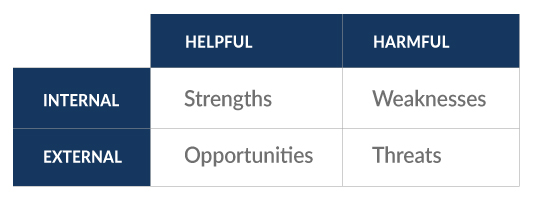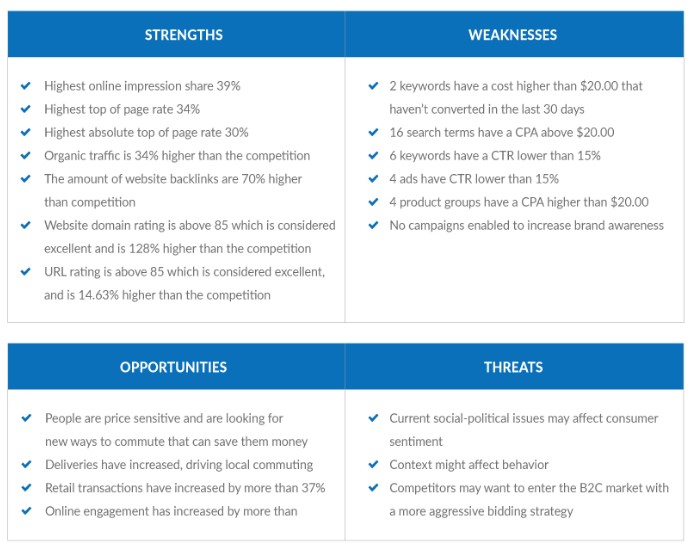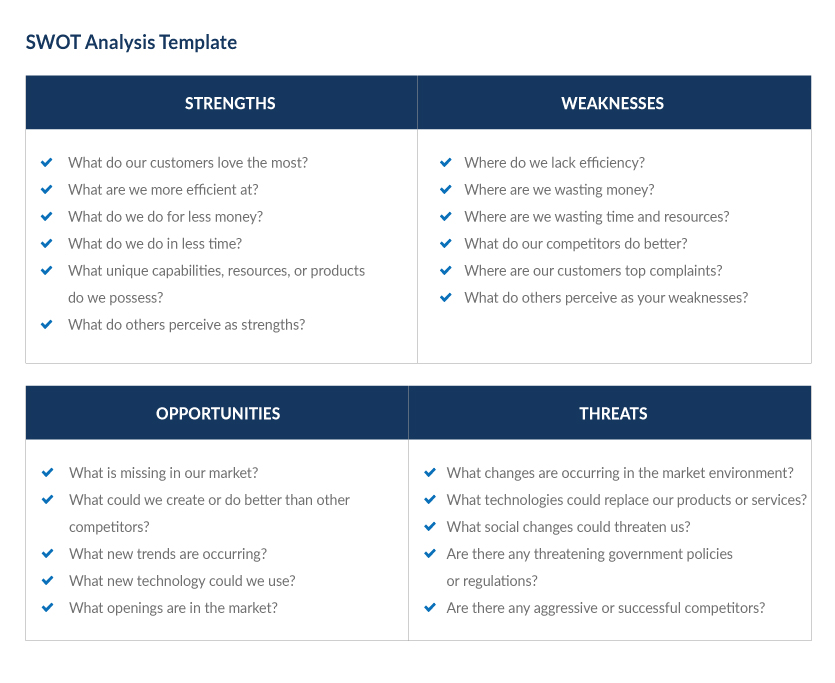[display-name-category]
[post_author]
Though the current challenges are new to us all, the methods to combat them are readily available. There are many different techniques to consider, but our strategists find great comfort and progress in a favorite in the business world; SWOT analysis.
Today, we’ll review the SWOT analysis to inform a marketer or business owner of the elements (internal and external) that play a role in achieving an objective. Sounds interesting? Read on for our step by step!
What Is a SWOT Analysis?
The wait is over. For those of you who have been wondering, the SWOT analysis stands for the following aspects of your business:
- Strengths
- Weaknesses
- Opportunities
- Threats
Reviewing each of these aspects allows internal teams to identify their business drivers and obstacles that can be used for strategic planning. The exercise strengthens understanding of one’s positioning by revealing the mix of internal and external parameters that contributes to performance.
Conducting a SWOT analysis is common and encouraged by digital marketing teams. You can practice this technique at the corporate, department, and team levels. Practical and effective, many individuals re-apply this method to gather meaningful information for personal growth.
Why Is a SWOT Analysis Important for Your Business Strategy?
The SWOT analysis directs strategic planning at every level–business, department, or project.
Whether you need to launch a new product or outrank competitors, the information gathered reveals the factors the team must consider before starting. Once completed, your team will have a clear understanding of what to leverage, omit, and counteract.

At White Shark Media, our digital marketing strategists frequent SWOT meetings before they begin an assignment. The team brainstorms on the factors that influence their goal. Each is encouraged to contribute ideas on how to deal with each of these elements.
How to Do a SWOT Analysis? Step by Step Process
To make your SWOT analysis more productive, start by defining your objective. Once you know what you want to achieve, it gets easier to analyze the internal and external factors that may affect or help you fulfill your strategic goal.
Strengths and Weaknesses
Your strengths are the internal elements that contribute to your success. The weaknesses are the internal factors that limit your ability to achieve your goals. First, you will identify each; then, you can address them.
Depending on what you are trying to achieve, some questions to ask are:
- What are some unique characteristics of your product, service, or project?
- Is your business location specific?
- What resources do you have? (Expertise, intellectual property, budget, equipment)
- What is your brand positioning?
- What are your core competencies and capabilities?
- How can the following areas help you achieve your goal? Management, operations or fulfillment, marketing, finances, human resources, and R&D
- Describe your business culture.
Here’s a hot tip! When answering these questions make sure to:
- Be precise (use adjectives and numbers in your description; verbose is better than vague)
- Be honest. Ignoring your faults will work against you.
- Do some benchmark to compare your company’s numbers to your competitors
- Consider all those resources that are unique and cannot be imitated as your definite strengths
For example:
- “Low CPA” is not a strength. If you change this to “CPA $20.00 vs Market CPA” you might have a clearer idea of why this is a strength.
Opportunities and Threats
Your opportunities are external forces, events, or ideas that generate revenue for your company.
The threats are all the external factors outside of your control that can harm you. As you understand what they are, list out contingency plan ideas to combat these elements to minimize or prevent their negative impact on your business.
While identifying your opportunities and threats, you should consider:
- Your competitor’s response to your business project or change
- The stability and health of the market
- Changes in consumer mindset and behavior
- The financial situation in the area where your business operates
- The current standing of suppliers or partners. For example, how stable is your primary supplier?
- Relevant government changes in law regulations
- Currency fluctuations
Examples of SWOT Analysis
Let’s assume you sell boutique bicycles to companies in the Hotel and Tourism Industry. You best reach your ideal audience through a B2B approach. The COVID-19 pandemic has caused a decrease in sales, which resulted in a switch to the B2C market. Before you make changes to your strategic plan, a SWOT Analysis of your current PPC campaigns will help you determine what to consider as you tackle this new market.
Goal: Increase sales by 55% with a CPA lower than $20.00 within three months

Note: You can get a complete analysis of your PPC accounts through AdInsights by White Shark Media, our automated PPC audit tool. AdInsights is part of our Compass Package, which helps marketing agencies to sell and fulfill PPC. Click here to learn more about White Shark Media’s Compass!
SWOT Analysis Template

Creating a Plan of Action to Tackle Your SWOT Analysis
A plan of action helps you understand how you can achieve your objectives. In this case, we’ll focus on the following:
- “Increase sales by 55% with a CPA lower than $20.00 within three months.”
With your goal in mind, consider the following points when drafting a plan of action:
- Write a SMART goal (specific, measurable, attainable, relevant, and time-sensitive)
- Aim for smaller victories to help you achieve your main goal. For example, if you want to increase your sales by 55% in 3 months, create a sales increase target for each month within your desired timeframe.
- List the actions you will take to achieve your goals.
- How will you overcome your weaknesses?
- How will you take advantage of your strengths and opportunities?
- What is your contingency plan in case your threats affect your plan?
- Schedule what needs to be done
- Police yourself and keep track of your progress
How to Overcome Challenges While Executing Your Plan of Action
Resistance to Change
Your new business and marketing strategy may involve drastic changes to your organization, such as adding a new business unit, restructuring, using new software, changing operational processes, and hiring new leaders or employees. Naturally, a portion of your team will resist these changes.
Depending on your business culture, the intensity of this struggle will vary. And, depending on where the resistance is coming from, it can prevent reaching the goal altogether. Here are some ways to address this issue:
- Identify which peers are having a hard time with changes. Red flags include:
- Discouraging behavior
- Attacking team members
- Avoiding
- Work as a team to help teammates cope with any confusion or frustrations. Our managers recommend one-on-ones or active listening.
- Aside from meetings, encourage constant communication. If individuals express themselves, they will explain their stance on the matter. From there, you can explain the reason for the changes and how it can benefit the business, as well as the individual.
Groupthink
Groupthink is a psychological phenomenon that occurs within communities and groups of people. The desire for acceptance and harmony takes over and drives individuals to think like one. As people strive for consensus within a group, it results in irrational, dysfunctional decisions and behavior.
This phenomenon’s influence can lead to a decrease in performance, customer dissatisfaction, employee unconformity, and ultimately failing to achieve your goals.
Sounds alarming, doesn’t it? Here are suggestions on how to determine red flags and practices to prevent this from occurring in your community or network.
Hints to identify this phenomenon
- Bonding is considered more important than freedom of expression
- Individuals are continually covering each other
- Group leaders are not impartial
- There is not a standard method to evaluate ideas and decisions
- Members’ social backgrounds and ideology are similar
- The group is under a lot of stress to perform and has experienced recent failures
- There is difficulty in making a decision
How to Avoid Groupthink
- Require everyone to evaluate ideas critically
- If you are leading the SWOT analysis or strategic planning, keep your opinions for the last and control your body language
- If the team has a lot of members, divide it into smaller groups, so they come up with solutions
- Examine all perspectives impartially and create evaluation methods
- Get an outsider’s perspective
- Have a devil’s advocate within meetings
- Have an open-door policy where employees can express new ideas as well as discomfort
PESTEL Analysis as an Alternative to the SWOT Analysis
A PESTEL Analysis (also known as PEST Analysis) is a tool that identifies all the external factors that can affect your business. PEST stands for political, economic, social, technological. Depending on the type of business, you can add areas such as ethical and legal.
The PESTEL analysis is a great way to do a situational analysis while coming up with a marketing plan. It helps organizations to be aware of the changes in the environment so they can respond and adapt fast.
Conclusion
As mentioned earlier, the techniques to get us through these times are available. There are many different techniques to consider; the SWOT analysis has contributed positively to our strategic planning as well as that of our partners.
For more on tested techniques and recommendations, follow our White Shark Media blog. It’s free and updated regularly!





